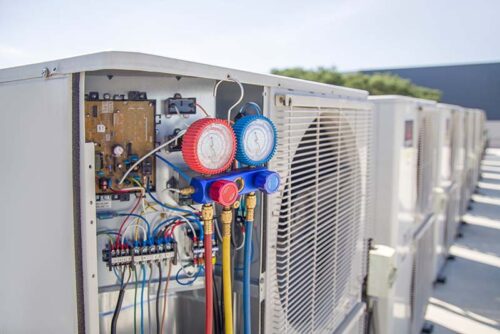LAST UPDATED 11/21/25: 2025 marked a turning point: R-410A is effectively being phased down, and new systems are migrating to A2L refrigerants — principally R-454B (and in some niches, R-32) — with much lower GWP. R-454B has about 78 % lower GWP than R-410A and is classified A2L (mildly flammable), which means design, safety, ventilation, leak detection, and charge limits have to be reconsidered.
That said, supply chain bottlenecks have already prompted the EPA to consider relaxing certain installation deadlines or grandfathering some inventories. For Donnelly’s audience, it’s worth flagging that system retrofits and replacements must now weigh both performance and compliance, and that equipment specs should explicitly account for new refrigerant characteristics.
—
With Local Law 97 and other various green initiatives impacting the HVAC industry, staying up-to-date with what new refrigerants are rising to the forefront. One of the most significant developments is the introduction of Refrigerant R-454B in recent years is the development of new refrigerants designed to be more environmentally friendly and efficient. Among these, R-454B stands out as a game-changer. This blog post aims to provide an in-depth look at R-454B, its benefits, and considerations for adoption by HVAC professionals, commercial business owners, and facility managers in NYC.
R-454B is a mix between R-1234yf, a hydrofluoroolefin (HFO), and R-32, a hydrofluorocarbon (HFC), and was developed as a lower Global Warming Potential (GWP) alternative to traditional refrigerants like R-410A. With increasing environmental regulations and a nationwide/international push towards sustainable solutions, understanding R-454B and its implications for commercial HVAC systems is more important than ever.
What Led to the Rise of R-454B?
To understand what makes R-454B so significant, it’s essential to understand the history of refrigerants. Refrigerants initially consisted of substances like ammonia and carbon dioxide, which were effective, but — as time later proved— were often toxic or flammable. The mid-20th century saw the rise of chlorofluorocarbons (CFCs) and hydrochlorofluorocarbons (HCFCs), such as R22, which were non-toxic and non-flammable, but had a devastating impact on the ozone layer — ultimately paving the way for, as the EPA puts, the phaseout of Ozone-Depleting Substances (ODS).
The Montreal Protocol of 1987 marked a turning point, leading to the phase-out of CFCs and, through 2016’s Kigali Amendment, HFCs. While these refrigerants were ozone-friendly, they still had high GWPs, contributing to global warming. This led to the development of HFOs like R-454B, which offer a much lower GWP without compromising performance.
Benefits of R-454B: Enhancing Energy Efficiency and Reducing Environmental Impact

Improved Energy Efficiency
One important benefits of R-454B is its superior energy efficiency. HVAC systems using R-454B can achieve better performance with lower energy consumption compared to traditional HFCs. This is particularly beneficial for commercial buildings, where HVAC systems account for a significant portion of overall energy use. The biggest benefits in this regard? Improved energy efficiency translates to lower energy bills for business owners and a reduced carbon footprint — helping owners on the path to Local Law 97 compliance as the restrictions continue to tighten.
Reduced Environmental Impact
R-454B has a GWP of just 466 — marking a notable 78% drop compared to R-410A’s GWP. This reduction in GWP makes R-454B a more environmentally friendly choice, aligning with global efforts to combat climate change. By adopting R-454B, commercial businesses can contribute to sustainability initiatives and meet New York State’s environmental regulations.
Enhanced System Performance
R-454B not only matches, but often exceeds the performance characteristics of R-410A. It offers excellent thermodynamic properties, ensuring optimal cooling capacity and system efficiency. For HVAC professionals, this means the ability to provide clients with high-performing, reliable systems that meet modern standards.
Considerations for Adoption: Factors to Keep in Mind
Compatibility
When transitioning to R-454B, compatibility with existing HVAC equipment may be throttled. While this refrigerant can be used in new systems designed specifically for it, retrofitting existing systems may require modifications. It’s essential to consult with manufacturers and HVAC experts to assess the feasibility and cost of such transitions.
Regulations and Safety Standards
Navigating the regulatory landscape is crucial when adopting new refrigerants. R-454B is classified as an A2L refrigerant, indicating low flammability. While this classification is favorable, it does require adherence to specific safety guidelines. HVAC professionals and facility managers must ensure compliance with local regulations and industry standards to ensure safe and effective implementation.
Training and Education
Adopting R-454B also necessitates proper training for HVAC technicians and facility managers. Understanding the handling, installation, and maintenance of systems using this refrigerant is essential for maximizing its benefits. Businesses in the HVAC industry should invest in training programs and provide education on best practices to ensure a smooth transition from R-410.
Making the Switch to R-454B with Donnelly
Overall, R-454B represents a significant advancement in the HVAC industry — as it offers substantial benefits in terms of energy efficiency, environmental impact, and system performance. For HVAC professionals, commercial business owners, and facility managers in NYC, understanding and adopting R-454B can lead to more sustainable, cost-effective, and high-performing HVAC systems.
For over 30 years, Donnelly Mechanical has remained at the forefront of technical innovation, as well as staying ahead of the curve in the HVAC industry. If your commercial business in New York City is looking to make the switch to R-454B, Donnelly has all the tools, resources, and expertise to bring your HVAC system up to speed.
To learn how you can improve your energy efficiency, best protect your HVAC system, and save money with R-454B, please visit Donnelly’s website and call us today at 718-865-2294 (718-886-1500 for Emergency Services)!